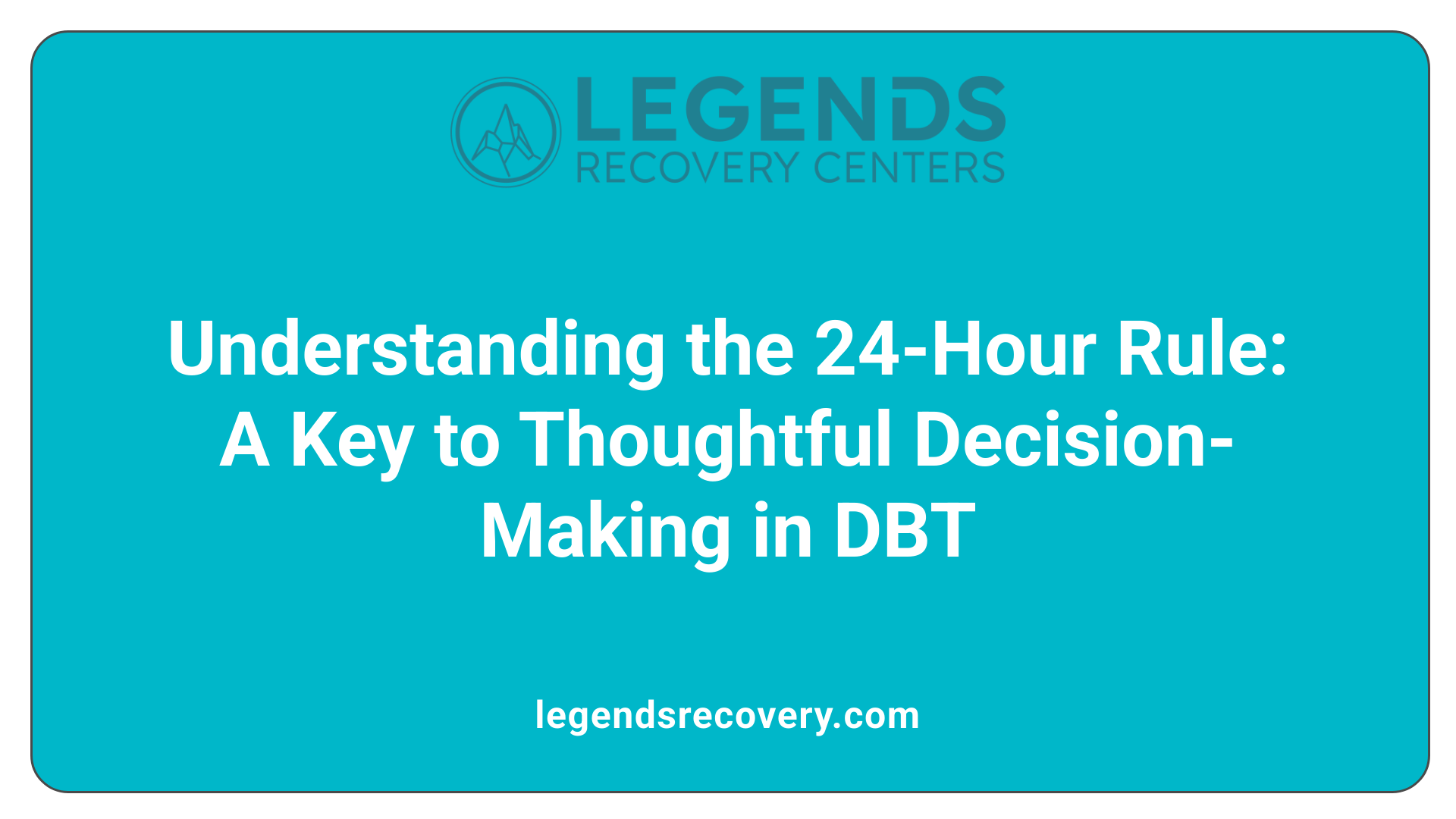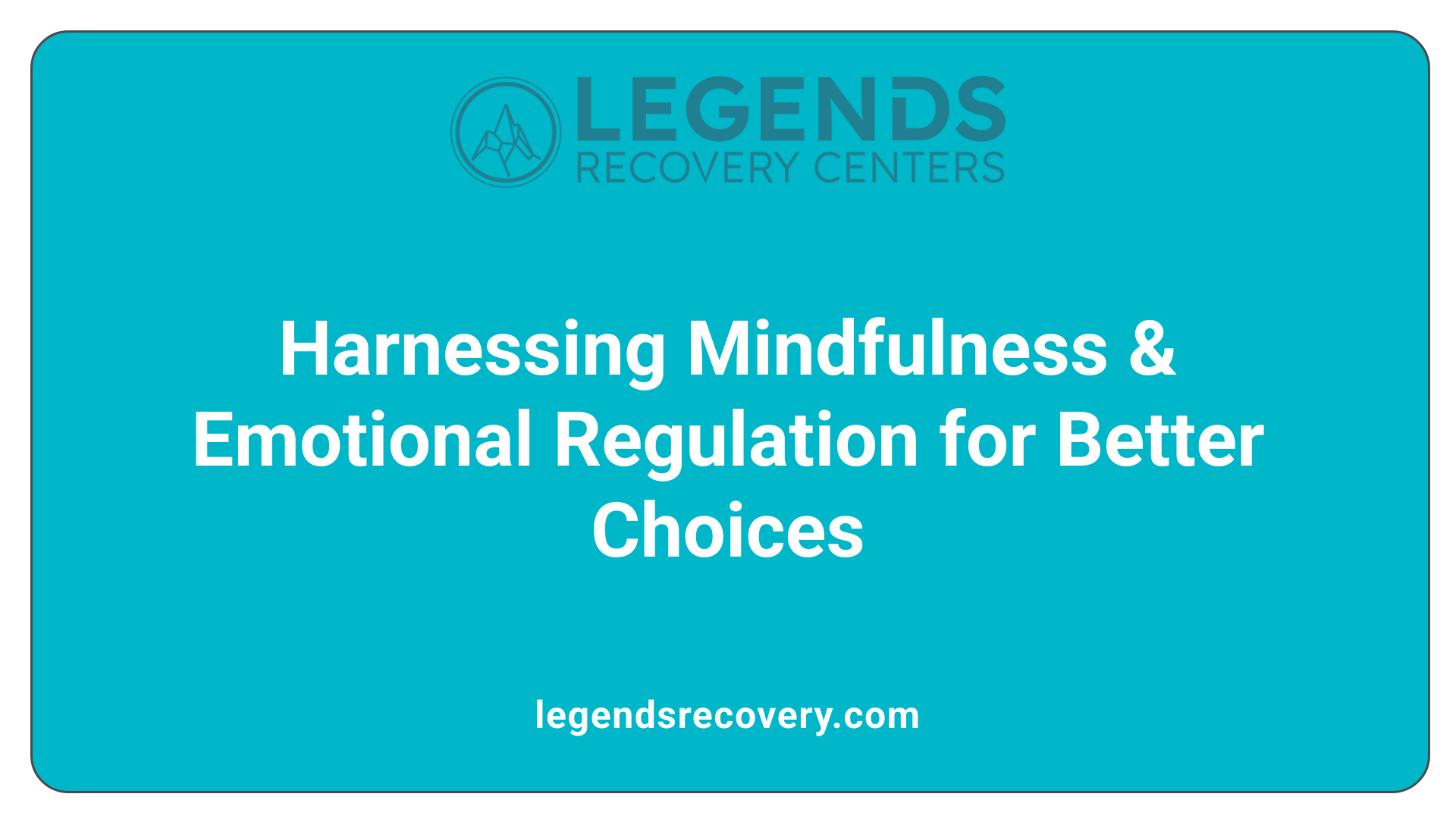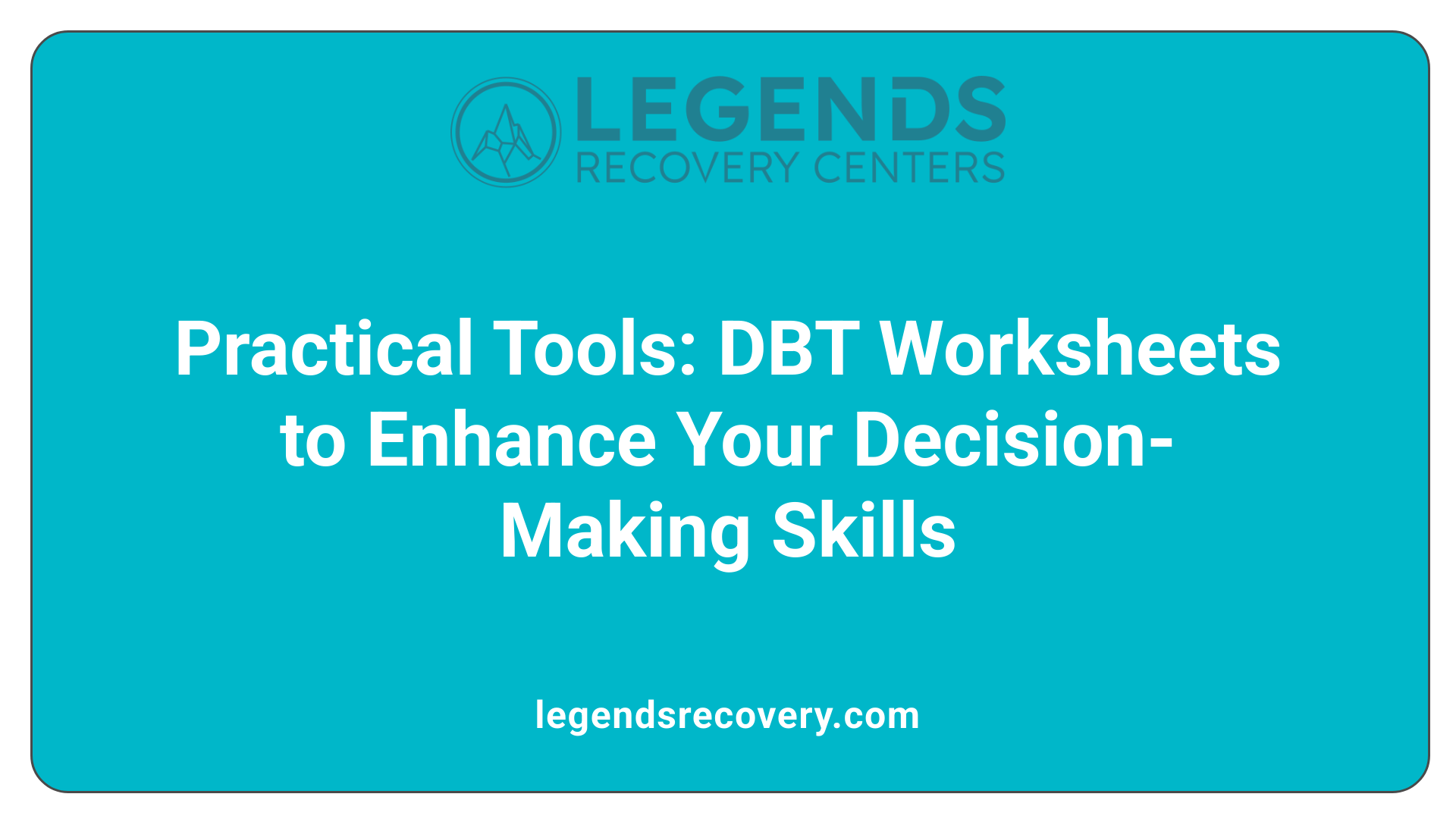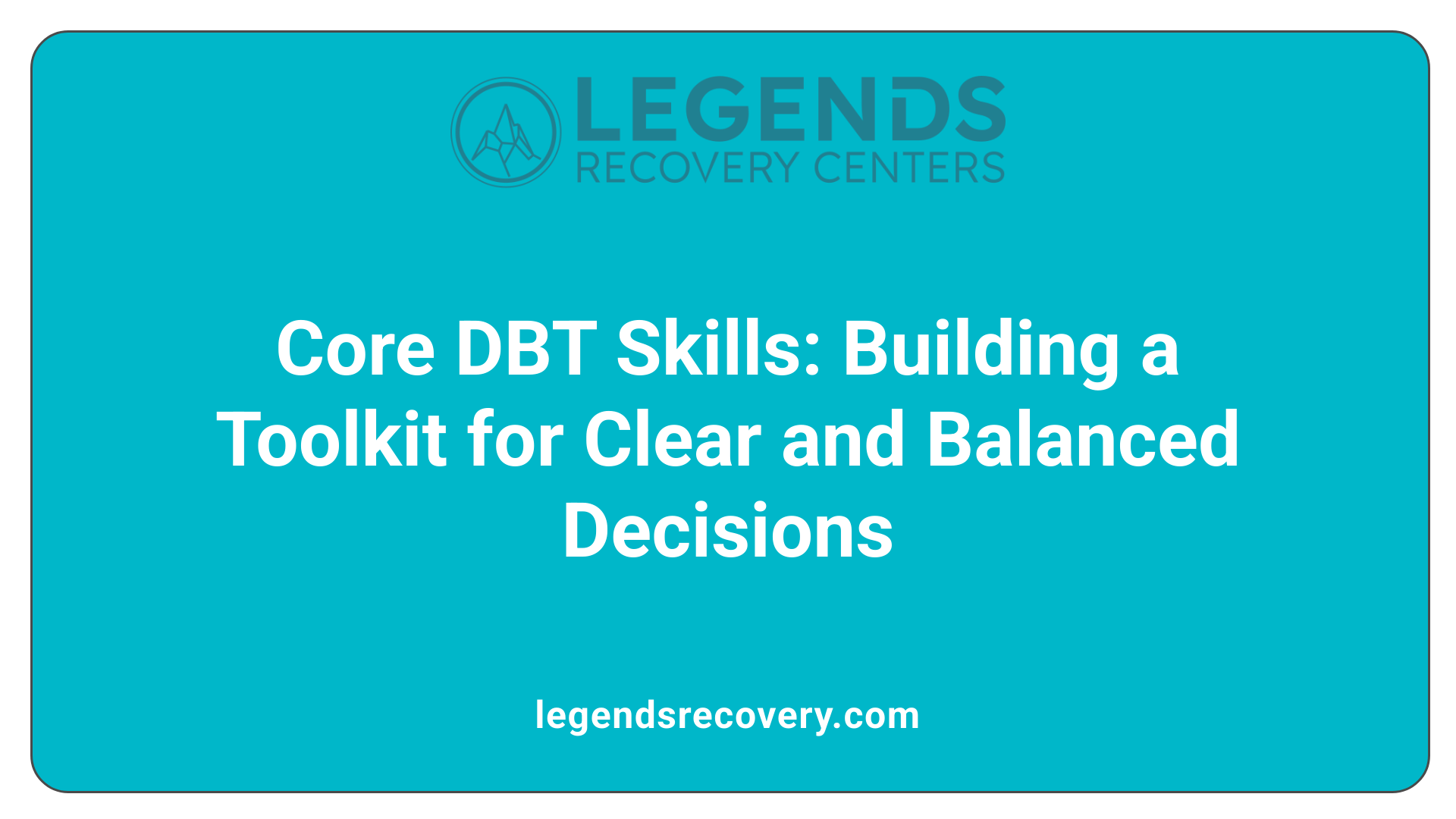Harnessing DBT Skills to Enhance Decision-Making

Dialectical Behavior Therapy (DBT) provides a comprehensive framework for improving decision-making skills through emotional regulation, mindfulness, and structured problem-solving techniques. Originally developed by Dr. Marsha Linehan for treating borderline personality disorder, DBT has expanded its application to various mental health challenges, emphasizing the importance of balancing acceptance and change. Its core modules—Mindfulness, Distress Tolerance, Emotion Regulation, and Interpersonal Effectiveness—equip individuals with practical skills to navigate complex decisions, especially when emotions run high.

The 24-hour rule in Dialectical Behavior Therapy (DBT) plays an important role in fostering healthier decision-making and emotional growth. Its main purpose is to prevent clients from making impulsive decisions that could reinforce harmful behaviors like self-harm or suicidal actions. Instead of seeking immediate help from their therapist after an incident, clients are encouraged to wait 24 hours.
This waiting period gives clients time to apply learned DBT skills such as mindfulness, distress tolerance, and emotion regulation. These skills help them manage intense feelings and reactions without rushing into impulsive or harmful actions. By doing so, they build greater self-reliance and confidence in their own ability to handle difficult situations.
The 24-hour rule also emphasizes that clients possess internal tools and resources to cope with distress. It encourages them to trust their ability to navigate crises with the skills they develop during therapy sessions. This approach reduces dependence on external intervention and promotes autonomy.
Furthermore, this rule helps clients see that change is possible. It fosters hope by showing that managing emotional distress is a gradual process requiring patience and practice. Over time, clients learn to make more balanced choices, which improves overall emotional regulation and decision-making accuracy.
In summary, the 24-hour rule is a vital component in DBT that enhances clients' capacity for thoughtful, deliberate decision-making. It supports them in managing impulsivity, strengthens their use of positive coping skills, and ultimately contributes to a more resilient, self-aware approach to life's challenges.

Mindfulness and emotional regulation play crucial roles in enhancing decision-making by fostering a deeper awareness of one's thoughts, feelings, and surroundings. When individuals practice mindfulness, they learn to observe their current mental and emotional states without immediate reaction or judgment. This awareness creates a mental space that allows for clearer and more deliberate choices.
By regulating emotions, individuals are less likely to act impulsively or be overwhelmed by intense feelings such as anger, fear, or sadness. This emotional balance promotes calmness and rational thinking, reducing the risk of decisions driven by temporary emotional turbulence.
Moreover, mindfulness encourages the assessment of options through a lens of curiosity and openness, helping people to consider the full scope of consequences and long-term implications. It supports a focus on values and priorities, enabling decisions that align with personal goals and ethical standards.
Practicing core skills like deep breathing, body scans, and mindful observation cultivates mental clarity and helps individuals tolerate ambiguity or uncertainty. This resilience diminishes biases like escalation of commitment or the sunk-cost fallacy.
Ultimately, mindfulness and emotional regulation transform reactive judgments into thoughtful, balanced decisions. They enhance problem-solving, foster innovation, and promote adaptive responses to challenges, making choices more consistent with one’s true interests and long-term well-being.
 Are there worksheets or tools available to practice DBT decision-making skills?
Are there worksheets or tools available to practice DBT decision-making skills?
Yes, numerous worksheets and digital resources are designed specifically to support individuals in practicing Dialectical Behavior Therapy (DBT) decision-making techniques. These tools include customizable PDFs and interactive online modules that target core DBT skills like mindfulness, emotion regulation, distress tolerance, and interpersonal effectiveness.
One popular worksheet is the "Wise Mind" activity, which helps individuals discern between their emotional and rational minds, leading to more balanced and thoughtful decisions. This exercise encourages reflection on feelings and logic, fostering a integrated perspective that aligns with personal values.
Another essential tool is the pros and cons or Decisional Balance list. It enables individuals to systematically evaluate the positives and negatives of a choice, helping to prevent impulsive reactions and promote rational decision-making. By listing benefits and potential drawbacks, users can visualize the outcomes of their choices more clearly.
Many of these worksheets are used in therapy settings but can also be adapted for personal use at home. They serve to deepen understanding of the decision-making process and help build skills that support emotional regulation and resilience in challenging situations.
Overall, the availability of these accessible tools makes practicing DBT’s structured approach to decision-making easier and more effective, contributing significantly to emotional growth and improved mental health.

Central to Dialectical Behavior Therapy (DBT) are skills designed to foster clear and balanced decision-making. One of the foundational skills is Wise Mind, which integrates rational thought and emotional intuition. This state allows individuals to make decisions that align with their values and current feelings, promoting clarity and self-awareness.
Alongside Wise Mind, the Pros and Cons skill is a practical decision-making tool. It involves listing the advantages and disadvantages of options to evaluate them objectively. This structured approach helps in weighing immediate versus long-term consequences, reducing impulsivity.
The PLEASE skills (Treat Physiology, Balance Eating, Avoid Mood-Altering Substances, Get Sleep, Exercise) are essential for stabilizing emotional states. Maintaining physical health directly impacts mental clarity, making decision-making more effective. When physical needs are met, individuals are better equipped to analyze situations calmly.
Another vital skill is the STOP technique, encouraging mindfulness through stopping, taking a step back, observing thoughts and feelings, and then proceeding intentionally. This pause prevents reactive responses and fosters considered actions.
Lastly, the TIP method (Take a step back, Identify options, Pros and cons) provides a systematic way to evaluate choices. It supports applying Wise Mind in real-time, helping individuals deliberate before acting.
In sum, these interconnected skills—Wise Mind, Pros and Cons, STOP, and TIP—form a toolkit that encourages thoughtful, emotion-aware, and value-driven decisions during challenging moments. Regular practice of these skills enhances emotional regulation and decision-making capacity, leading to more adaptive and fulfilling life choices.
The DBT decision-making process, as explained by Ashley Allen, involves a structured evaluation of options to promote confidence and clarity. It begins with defining the problem clearly and assessing whether it is changeable.
Once the issue is understood, individuals consider four main strategies: solving the problem directly, finding ways to feel better about it, practicing radical acceptance to accept the situation as it is, or deciding to remain in the current state without attempting change.
A crucial part of this process is the expanded pros and cons method. People list the benefits and drawbacks of both acting and not acting, encouraging a balanced review of potential outcomes. This thorough approach helps individuals make decisions that support their long-term goals and emotional health.
The process starts with taking a moment to pause and clearly define what the problem or decision is. This step involves mindfulness skills to observe the issue without judgment, ensuring that one understands the situation thoroughly.
Clarifying the problem also means recognizing emotional triggers and assessing whether the problem is changeable. Deciding if change is possible or if acceptance is the better route is vital for managing emotional reactions.
After clarity, the next step involves evaluating whether the situation can be changed or if acceptance should be practiced. If the problem is changeable, problem-solving skills are used to develop a plan of action.
If the problem is not changeable, or if immediate change does not seem feasible, practicing radical acceptance can bring peace and reduce suffering.
Alongside this, the individual considers four options: actively solving the problem, finding ways to improve emotional state, accepting the reality, or choosing to stay in place. Each option is explored carefully to understand its implications.
The pivotal part of DBT's decision-making model is listing pros and cons for each option. This list includes benefits and disadvantages of doing or not doing an action, fostering rational and emotional awareness.
By objectively weighing these points, individuals can select the most suitable course of action, enhancing their confidence and emotional resilience.
Finally, the process involves considering how each decision aligns with one’s long-term values and goals. Sometimes, choosing an option that offers quick relief may not serve future well-being.
DBT encourages reflective practice, journaling, or seeking advice aligned with personal values to ensure decisions contribute to a more satisfying life.
By following this structured process, individuals learn to slow down, reflect, and make choices that promote emotional stability and personal growth. Integrating these steps into daily routines can significantly improve crisis management and overall mental health.
Dialectical Behavior Therapy (DBT) is particularly effective for helping young adults improve their decision-making skills. Central to this support are skills such as mindfulness, emotional regulation, distress tolerance, and interpersonal effectiveness. These tools enable young adults to better manage intense emotions, reduce impulsivity, and respond thoughtfully to stressful situations.
A specific DBT skill, Pros and Cons, guides individuals to weigh the positive and negative consequences of their choices. This structured process encourages careful reflection, preventing hasty or impulsive reactions that are common in adolescence and early adulthood. By examining the potential outcomes, young people can align their decisions with long-term goals and personal values.
Self-awareness and reflection are crucial components. DBT promotes looking back at past experiences, learning from outcomes, and considering multiple perspectives, including family input and peer insights. Additionally, using practical tools such as visual decision grids or worksheets can make the process clearer and more manageable.
The role of DBT in fostering responsibility lies in empowering young adults to consider the broader implications of their actions. It encourages long-term thinking, patience, and self-control, which are essential for responsible independence. Incorporating family support and tangible decision-making aids reinforces these skills, making good choices more attainable.
Overall, DBT provides young adults with a comprehensive toolkit for responsible decision-making. These skills support emotional resilience, promote self-awareness, and help them navigate life’s challenges thoughtfully, leading to healthier outcomes now and in the future.
Research indicates that Dialectical Behavior Therapy (DBT) can lead to significant changes in brain architecture. These modifications help improve emotional regulation and decision-making capabilities. Over time, the brain adapts by strengthening areas responsible for cognitive control and behavioral regulation.
One of the primary areas affected by DBT is the prefrontal cortex, which is crucial for rational thought, impulse control, and executive functions. Regular practice of DBT skills enhances activity in this region, allowing individuals to better evaluate situations, weigh options, and make thoughtful decisions.
The amygdala, known for processing emotions like fear and anger, shows decreased activity following DBT. This reduction supports better management of emotional reactions, making decision-making less impulsive and more balanced, even during high-stress moments.
Neuroscientific studies suggest that the brain adaptations from DBT are enduring. These lasting changes involve improved connectivity between cognitive control centers and emotional processing areas. As a result, individuals are equipped to handle future emotional challenges with greater resilience and rationality.
| Brain Region | Effect of DBT | Impact on Decision-Making | Underlying Changes |
|---|---|---|---|
| Prefrontal Cortex | Increased activity | Enhanced planning, impulse control | Strengthened neural pathways for executive functioning |
| Amygdala | Decreased activity | Reduced emotional reactivity | Diminished overactivation in response to emotional stimuli |
| Connectivity between regions | Improved communication | Better integration of thought and emotion | Neural reorganization promoting balanced responses |
Through targeted therapy, these neural changes foster more deliberate and adaptive decision-making, helping individuals respond wisely rather than impulsively.
Through a combination of mindfulness, emotional regulation, and practical decision-making tools like Pros and Cons, DBT provides a powerful framework for improving decision quality. Its emphasis on self-awareness, deliberate reflection, and skill mastery empowers individuals to navigate life’s challenges more effectively. As research continues to reveal neurological benefits and long-term behavioral improvements, incorporating DBT into daily routines can lead to more thoughtful, resilient, and value-driven decisions, ultimately enhancing overall well-being.